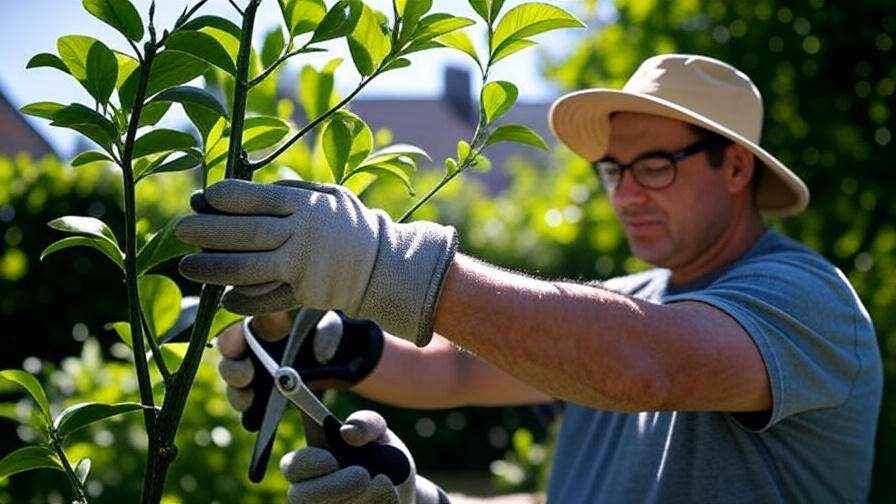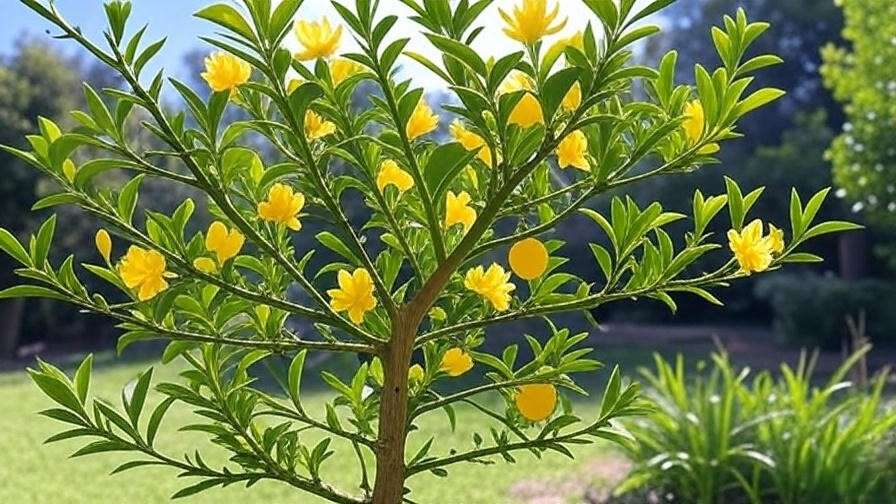Imagine transforming your garden with a striking lemon thorn tree, its vibrant foliage and lemon-scented leaves stealing the show! 🌞 This resilient, eye-catching tree not only elevates your landscape but also supports local wildlife and thrives in challenging conditions. Whether you’re a seasoned gardener or a beginner, growing a lemon thorn tree (Vachellia karroo or similar species) can be deeply rewarding with the right knowledge. In this comprehensive guide, we’ll share expert tips, step-by-step instructions, and practical solutions to help you cultivate a healthy, thriving lemon thorn tree. From planting to pest control, we’ve got you covered to ensure your garden flourishes! 🌿
This article dives deep into everything you need to know about lemon thorn tree care, addressing common challenges and offering actionable advice to create a stunning, sustainable landscape. Let’s get started on your journey to growing a tree that’s as beautiful as it is resilient! 🌳
1. Understanding the Lemon Thorn Tree 🌼
1.1 What Is a Lemon Thorn Tree? 🧐
The lemon thorn tree, often referred to as Vachellia karroo (formerly Acacia karroo), is a hardy, deciduous tree native to southern Africa. Known for its thorny branches, lush green foliage, and distinctive lemony fragrance, this tree is a favorite in ornamental gardening and ecological restoration. Growing up to 12 meters tall, it boasts bright yellow pom-pom flowers that attract pollinators like bees and butterflies. Its deep root system makes it drought-tolerant, ideal for arid climates. The lemon thorn tree thrives in USDA hardiness zones 8-11, adapting well to various soil types, though it prefers well-draining conditions. Its resilience and beauty make it a versatile choice for homeowners and landscapers aiming to enhance their outdoor spaces with a low-maintenance, eco-friendly tree. 🌞

1.2 Benefits of Growing a Lemon Thorn Tree 🌟
Planting a lemon thorn tree brings a host of benefits to your garden and beyond. Aesthetically, its vibrant foliage and golden blooms add texture and color, creating a focal point in any landscape. Environmentally, it supports biodiversity by attracting pollinators and providing shade for smaller plants. Its deep roots help prevent soil erosion, making it a smart choice for sloped or windy areas. Practically, the tree’s thorny nature makes it an excellent natural barrier or hedge, deterring unwanted visitors while adding privacy. In some regions, its wood and bark are used for traditional crafts or medicinal purposes, showcasing its cultural significance. By choosing a lemon thorn tree, you’re investing in a sustainable, visually stunning addition that enhances both your garden’s beauty and its ecological value. 🌍

1.3 Common Varieties and Their Features 🌿
Lemon thorn trees come in several varieties, each with unique traits suited to different environments. The most common, Vachellia karroo, is prized for its fast growth (up to 1 meter per year) and adaptability to dry climates. Vachellia xanthophloea (fever tree), another relative, features striking yellow-green bark and thrives in wetter conditions. For smaller gardens, Vachellia tortilis offers a compact, umbrella-shaped canopy. Below is a comparison of popular varieties:
| Variety | Height | Climate | Key Features |
|---|---|---|---|
| Vachellia karroo | 6-12m | Arid, temperate | Fast-growing, drought-tolerant, thorny |
| Vachellia xanthophloea | 10-15m | Warm, moist | Yellow bark, ornamental, pollinator-friendly |
| Vachellia tortilis | 4-8m | Dry, hot | Compact, umbrella canopy, erosion control |
Choosing the right variety depends on your climate, space, and aesthetic goals. Consult local nurseries for region-specific advice. 🌱

2. Planting Your Lemon Thorn Tree: Getting Started Right 🌱
2.1 Choosing the Perfect Location 📍
Selecting the right spot is critical for your lemon thorn tree’s success. These trees thrive in full sun, requiring at least 6-8 hours of direct sunlight daily. Choose a location with well-draining soil to prevent root rot, as waterlogged conditions can harm the tree. Consider your climate: Lemon thorn trees flourish in warm, arid regions but can tolerate light frost in zones 8-11. Avoid planting near structures or power lines, as their thorny branches and deep roots can cause issues. Common mistakes include planting in heavy shade or overly compacted soil, which stunts growth. For hedges, space trees 2-3 meters apart to allow for airflow and growth. Check local regulations, as some areas consider certain Vachellia species invasive. A well-chosen site sets the foundation for a healthy tree!
2.2 Preparing the Soil for Success 🏜️
Lemon thorn trees prefer slightly acidic to neutral soil (pH 6.0-7.5) with excellent drainage. Test your soil using a home kit or send a sample to a local extension service for analysis. If your soil is clay-heavy or overly alkaline, amend it with organic matter like compost or well-rotted manure to improve texture and nutrient content. For sandy soils, add organic mulch to retain moisture. Before planting, loosen the soil to a depth of 50 cm to encourage deep root growth. Expert Tip: Mix in a handful of bone meal to boost phosphorus, promoting strong root development. Avoid over-amending, as excessive nutrients can lead to weak growth. Proper soil preparation ensures your lemon thorn tree establishes quickly and thrives for years.
2.3 Planting Techniques for Healthy Establishment 🌳
Planting a lemon thorn tree correctly sets it up for long-term success. Follow these steps:
- Dig the Hole: Make it twice as wide and as deep as the root ball.
- Prepare the Tree: Gently tease the roots if pot-bound and remove any damaged ones.
- Position the Tree: Place it in the hole, ensuring the root collar is level with the soil surface.
- Backfill: Fill with native soil, tamping lightly to remove air pockets.
- Water Thoroughly: Soak the area to settle the soil.
- Mulch: Apply a 5-10 cm layer of organic mulch (e.g., wood chips) around the base, keeping it 5 cm from the trunk.
For hedges, plant 2-3 meters apart. Water weekly for the first 3 months to establish roots. A visual planting checklist can streamline this process for beginners. 🌱

3. Caring for Your Lemon Thorn Tree: Essential Maintenance Tips 🌿
3.1 Watering Needs and Best Practices 💧
Proper watering is key to a healthy lemon thorn tree. Young trees need consistent moisture—water deeply once a week, providing 20-30 liters depending on soil type. Mature trees are drought-tolerant and may only need supplemental watering during prolonged dry spells. In arid climates, water every 2-3 weeks during summer. Watch for signs of trouble: yellowing leaves may indicate overwatering, while wilting suggests underwatering. To avoid root rot, ensure the soil dries out slightly between waterings. Seasonal Tip: Reduce watering in winter when the tree is dormant. Use a soaker hose for efficient, deep watering, and always check soil moisture with a finger test (2-3 cm deep) before adding more water. Proper hydration keeps your tree vibrant and resilient.
3.2 Fertilizing for Optimal Growth 🌱
Lemon thorn trees are low-maintenance but benefit from occasional fertilization. Use a balanced fertilizer (e.g., 10-10-10 NPK) or organic compost in early spring to support new growth. Apply 100-200 grams per tree, depending on size, spreading it evenly around the drip line. Avoid high-nitrogen fertilizers, which can promote weak, leggy growth. For young trees, fertilize twice yearly (spring and early summer); mature trees need only one application. Expert Insight: Over-fertilizing can stress the tree, leading to pest susceptibility. Always water thoroughly after applying fertilizer to help nutrients reach the roots. If your soil is nutrient-rich, skip fertilization and rely on organic mulch to provide slow-release nutrients. A tailored fertilization plan ensures your lemon thorn tree grows strong without excess stress. 🌿
3.3 Pruning and Shaping Your Tree ✂️
Pruning your lemon thorn tree promotes healthy growth, enhances its shape, and prevents thorny branches from becoming a hazard. The best time to prune is late winter or early spring, before new growth begins. Use sharp, sterilized pruning shears to avoid spreading disease. Start by removing dead, damaged, or crossing branches to improve airflow and light penetration. For aesthetic shaping, trim back overly long branches to maintain a balanced canopy. Be cautious of the tree’s sharp thorns—wear thick gloves and protective clothing. For young trees, focus on establishing a strong central leader; for mature trees, limit pruning to maintenance. Expert Tip: Never remove more than 25% of the canopy at once to avoid stressing the tree. Regular pruning keeps your lemon thorn tree healthy and visually appealing. 🌳

3.4 Pest and Disease Management 🐞
Lemon thorn trees are generally hardy but can face pests like aphids, scale insects, and borers, as well as diseases such as root rot or powdery mildew. Inspect your tree regularly for signs like sticky residue (aphids), discolored bark (scale), or wilting (root rot). For pests, use neem oil or insecticidal soap as eco-friendly solutions, applying early in the morning for best results. To prevent root rot, ensure proper drainage and avoid overwatering. Powdery mildew, common in humid conditions, can be treated with a fungicide or a baking soda solution (1 tbsp per liter of water). Preventative Checklist: Maintain good airflow through pruning, avoid overhead watering, and apply mulch to reduce soil-borne pathogens. Early intervention and organic methods keep your tree thriving and pest-free. 🌿
4. Troubleshooting Common Lemon Thorn Tree Problems 🛠️
4.1 Why Is My Lemon Thorn Tree Not Thriving? 🤔
If your lemon thorn tree shows signs of distress—yellowing leaves, stunted growth, or wilting—it’s time to diagnose the issue. Common causes include improper watering, poor soil conditions, or pest infestations. Yellow leaves often signal overwatering or nutrient deficiency, while wilting may indicate underwatering or root damage. Stunted growth can result from compacted soil or insufficient sunlight. Conduct a quick assessment: check soil moisture, test pH (ideal range: 6.0-7.5), and inspect for pests. Environmental factors like frost or extreme heat can also stress the tree. Keeping a gardening journal to track care routines can help pinpoint issues. Addressing problems early prevents long-term damage and ensures your tree regains its vigor. 🌞
4.2 Solutions for Common Issues 💡
Once you’ve identified the problem, take targeted action. For overwatering, improve drainage by adding sand or gravel to the soil and reduce watering frequency. For nutrient deficiencies, apply a balanced fertilizer or compost, ensuring proper application around the drip line. If pests are present, use organic treatments like neem oil and remove affected branches. For compacted soil, aerate the root zone with a garden fork. Case Study: A gardener in Arizona revived a wilting lemon thorn tree by improving drainage with raised beds and reducing watering to biweekly, resulting in vibrant growth within months. Always monitor your tree’s response to changes and adjust care accordingly. With the right solutions, your lemon thorn tree can bounce back beautifully. 🌱
5. Advanced Tips for a Thriving Lemon Thorn Tree 🌟
5.1 Companion Planting for Enhanced Growth 🌼
Companion planting can boost your lemon thorn tree’s health and garden ecosystem. Pair it with pollinator-friendly plants like lavender, marigolds, or salvia to attract bees and butterflies, enhancing pollination and biodiversity. Nitrogen-fixing plants like clover or alfalfa can enrich the soil naturally, reducing the need for fertilizers. Avoid planting water-hungry species nearby, as they may compete with your tree’s deep roots. For example, planting marigolds around the base can deter aphids while adding vibrant color. Expert Insight: Companion plants also improve soil structure and reduce erosion, complementing the lemon thorn tree’s natural benefits. Choose species suited to your climate for a harmonious, low-maintenance garden. This approach creates a thriving, eco-friendly landscape. 🌿

5.2 Propagating Lemon Thorn Trees 🌱
Propagating lemon thorn trees allows you to expand your garden or share with others. Two effective methods are seed propagation and cuttings:
- Seeds: Soak seeds in warm water for 24 hours to soften the hard coat, then plant in a well-draining seed mix. Keep soil moist and place in a sunny spot. Germination takes 2-4 weeks.
- Cuttings: Take 15 cm semi-hardwood cuttings in spring, dip in rooting hormone, and plant in a mix of sand and peat. Mist regularly and expect roots in 6-8 weeks.
Success Tip: Use a heat mat for seed propagation to maintain consistent warmth (20-25°C). Patience and proper care yield healthy new trees for your landscape. 🌳
5.3 Seasonal Care Calendar 📅
A tailored care schedule ensures your lemon thorn tree thrives year-round. Here’s a month-by-month guide:
- Spring: Fertilize, prune lightly, and check for pests. Start watering weekly for young trees.
- Summer: Water biweekly in dry climates, mulch to retain moisture, and monitor for aphids.
- Fall: Reduce watering and apply a final light fertilizer dose. Remove fallen leaves to prevent fungal issues.
- Winter: Prune dormant trees, avoid fertilizing, and protect young trees from frost with burlap wraps.
This calendar aligns with the tree’s natural growth cycle, ensuring optimal health. Adjust based on your local climate—consult a regional gardening guide for precision. Consistent care keeps your tree vibrant through every season. 🌞
6. Environmental and Cultural Significance of Lemon Thorn Trees 🌍
Lemon thorn trees play a vital role in their native ecosystems, particularly in African savannas. Their flowers attract pollinators, supporting biodiversity, while their deep roots stabilize soil, preventing erosion. Wildlife, like birds and antelopes, rely on the tree for shade and food. In cultural contexts, indigenous communities use the bark and roots for traditional medicine, treating ailments like fevers or infections. The wood is valued for crafting tools or fencing. By planting a lemon thorn tree, you contribute to sustainable gardening, promoting eco-friendly landscapes that benefit both nature and communities. Sustainability Tip: Source trees from reputable nurseries to avoid invasive spread in non-native regions. This tree’s legacy is both ecological and cultural. 🌿
7. FAQs About Lemon Thorn Tree Care ❓
Q: How fast does a lemon thorn tree grow?
A: It grows up to 1 meter per year under ideal conditions, reaching maturity in 5-7 years.
Q: Are lemon thorn trees invasive?
A: Some varieties, like Vachellia karroo, can be invasive in non-native areas. Check local regulations before planting.
Q: Can I grow a lemon thorn tree in a pot?
A: Young trees can be potted, but their deep roots require large containers or eventual transplanting.
Q: How do I protect my tree from frost?
A: Wrap young trees in burlap and mulch heavily around the base during winter.
Q: Why are my tree’s leaves turning yellow?
A: This often indicates overwatering or nutrient deficiency. Test soil and adjust care.
Q: Do lemon thorn trees attract pests?
A: They can attract aphids or scale but are manageable with neem oil.
Q: How much space does a lemon thorn tree need?
A: Allow 3-5 meters for single trees or 2-3 meters for hedges.
8. Conclusion: Your Path to a Thriving Lemon Thorn Tree 🌳
Growing a lemon thorn tree is a rewarding journey that enhances your garden’s beauty and ecological value. By choosing the right location, preparing the soil, and following consistent care practices—like proper watering, fertilizing, and pruning—you’ll cultivate a vibrant, resilient tree. Address challenges like pests or poor growth with our troubleshooting tips, and elevate your garden with companion planting and propagation. This guide equips you with expert-backed strategies to ensure success. Start planting today, and share your experiences in the comments or explore our related articles on drought-tolerant trees and sustainable gardening. For personalized advice, contact a local arborist. Your lemon thorn tree will thrive, transforming your landscape for years to come!













